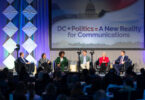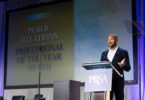Artificial intelligence is now “everywhere in advertising, marketing and public relations,” Lorra M. Brown said. “We’ve been overloaded by the onslaught” of AI.
Brown, an assistant professor in the Hussman School of Journalism and Media at the University of North Carolina at Chapel Hill, was the guest on Oct. 23 for Strategies & Tactics Live, PRSA’s monthly livestream on LinkedIn. (Watch the full episode here.) One day earlier, her article “10 Emerging Career Paths in an AI-Influenced Landscape” was published on PRSA’s PRsay blog.
John Elsasser, editor-in-chief of PRSA’s Strategies & Tactics publication and host of S&T Live, asked Brown how she defines AI literacy for public relations students and professionals.

Being literate about artificial intelligence in PR means “understanding how to use AI tools in ways that serve your stakeholders or audiences, while also upholding professional standards,” she said. “We want any new technology to enhance, and not replace, the critical thinking and problem-solving judgment” of people.
Within the PR profession, there’s been much talk about “prompt engineering,” or knowing how to ask AI chatbots the right questions, she said. But “Our aspiring professionals are still developing their problem-solving and critical-thinking skills. How do we help them understand and not be afraid of the technology, and still have that analytical ability, that ethical, critical lens and some cautious skepticism?”
Soft skills remain essential
Even as young PR professionals enter a changed industry, one in which they will likely have AI co-workers, “soft skills are still important,” Brown said. “You have to know how to make eye contact, to have conversation skills, to listen, to get along with people, and work with people who are different culturally or who have different backgrounds or work styles.”
As AI pervades communications and the world, the need to maintain “humanity and human-interaction ability is never going to go away,” she said. “In fact, it’s now more important than ever.”
Artificial intelligence that generates texts, images and audio is praised for saving time, but the technology also churns out “deep fakes” and “AI slop,” she said. “How do we verify facts and help our organizations [mitigate] the vulnerabilities and risks that come with AI?”
When using generative AI, the goal should be to create content that’s ethical and authentic, she said.
Elsasser asked how PR professionals can work with educators to help close the skill gaps that AI is rendering within the industry.
For college professors, “We have to rethink how we’re teaching” and “use AI along with our traditional skills,” she said. “That means moving beyond lectures” to include experiential learning in real-world circumstances, and bringing more industry professionals into the classroom.
Educators “have an opportunity to build stronger partnerships with agency and industry professionals, and potentially even to embed micro-internships into the curriculum,” Brown said. Doing so will help students learn to think critically under pressure and prepare them for the realities of the working world, she said.
As Brown tells her students about AI, “You don’t have to have it all figured out. None of us does. Be cautiously skeptical, but continually curious, not fearful. Remember that public relations is always resilient.”
Here, Brown answers questions in the S&T Live lightning-round session:
Photo credit: adobe art







